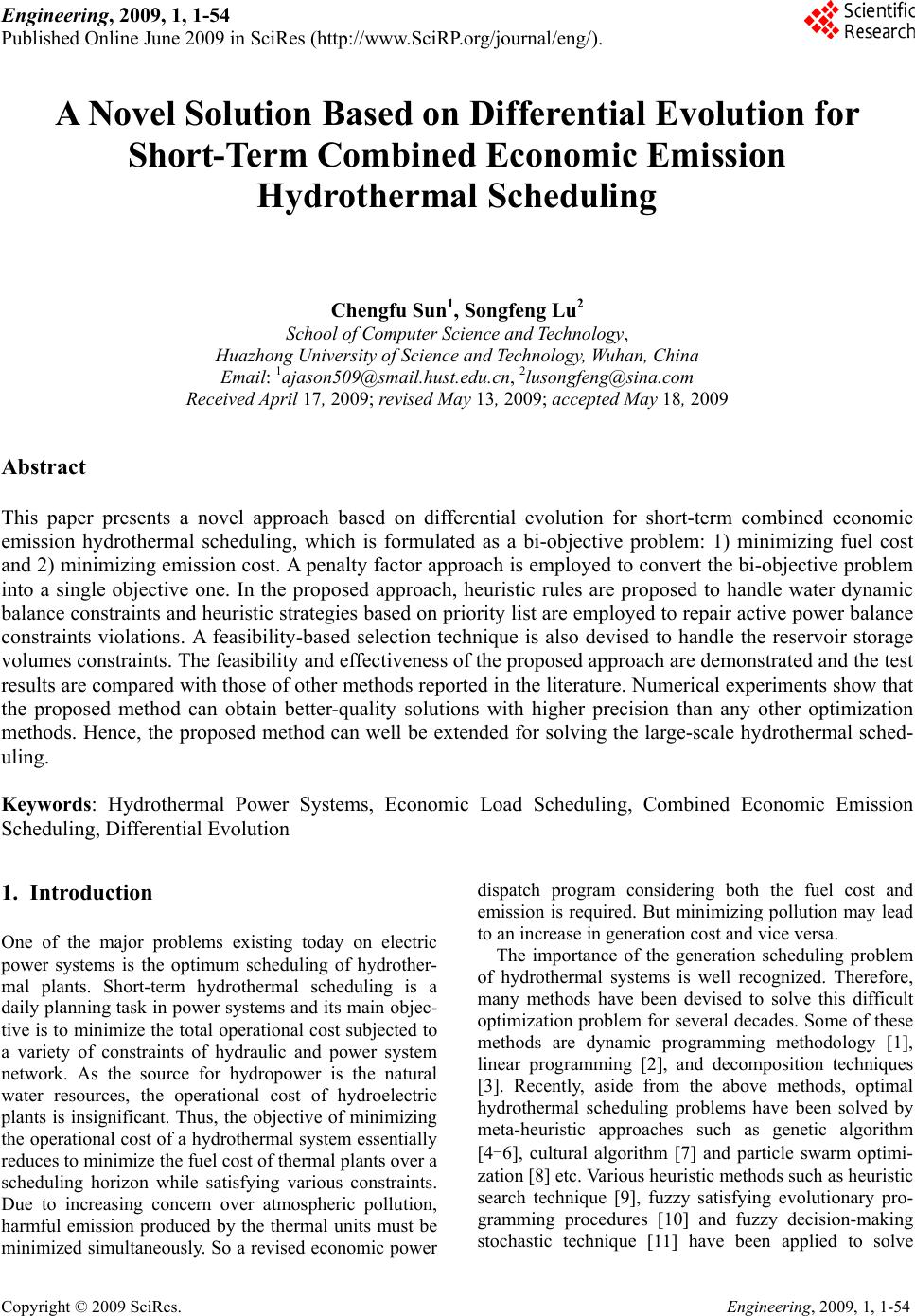 Engineering, 2009, 1, 1-54 Published Online June 2009 in SciRes (http://www.SciRP.org/journal/eng/). Copyright © 2009 SciRes. Engineering, 2009, 1, 1-54 A Novel Solution Based on Differential Evolution for Short-Term Combined Economic Emission Hydrothermal Scheduling Chengfu Sun1, Songfeng Lu2 School of Computer Science and Technology, Huazhong University of Science and Technology, Wuhan, China Email: 1ajason509@smail.hust.edu.cn, 2lusongfeng@sina.com Received April 17, 2009; revised May 13, 2009; acce pted May 18, 2009 Abstract This paper presents a novel approach based on differential evolution for short-term combined economic emission hydrothermal scheduling, which is formulated as a bi-objective problem: 1) minimizing fuel cost and 2) minimizing emission cost. A penalty factor approach is employed to convert the bi-objective problem into a single objective one. In the proposed approach, heuristic rules are proposed to handle water dynamic balance constraints and heuristic strategies based on priority list are employed to repair active power balance constraints violations. A feasibility-based selection technique is also devised to handle the reservoir storage volumes constraints. The feasibility and effectiveness of the proposed approach are demonstrated and the test results are compared with those of other methods reported in the literature. Numerical experiments show that the proposed method can obtain better-quality solutions with higher precision than any other optimization methods. Hence, the proposed method can well be extended for solving the large-scale hydrothermal sched- uling. Keywords: Hydrothermal Power Systems, Economic Load Scheduling, Combined Economic Emission Scheduling, Differential Evolution 1. Introduction One of the major problems existing today on electric power systems is the optimum scheduling of hydrother- mal plants. Short-term hydrothermal scheduling is a daily planning task in power systems and its main objec- tive is to minimize the to tal operational cost subjected to a variety of constraints of hydraulic and power system network. As the source for hydropower is the natural water resources, the operational cost of hydroelectric plants is insignificant. Thus, the objective of minimizing the operational cost of a hydrothermal system essentially reduces to minimize the fuel cost of thermal plants over a scheduling horizon while satisfying various constraints. Due to increasing concern over atmospheric pollution, harmful emission produced by the thermal units must be minimized simultaneously. So a revised economic power dispatch program considering both the fuel cost and emission is required. But minimizing pollution may lead to an increase in generation cost and vice versa. The importance of the generation scheduling problem of hydrothermal systems is well recognized. Therefore, many methods have been devised to solve this difficult optimization problem for several decades. Some of these methods are dynamic programming methodology [1], linear programming [2], and decomposition techniques [3]. Recently, aside from the above methods, optimal hydrothermal scheduling problems have been solved by meta-heuristic approaches such as genetic algorithm [4-6], cultural algorithm [7] and particle swarm optimi- zation [8] etc. Various heuristic methods such as heuristic search technique [9], fuzzy satisfying evolutionary pro- gramming procedures [10] and fuzzy decision-making stochastic technique [11] have been applied to solve 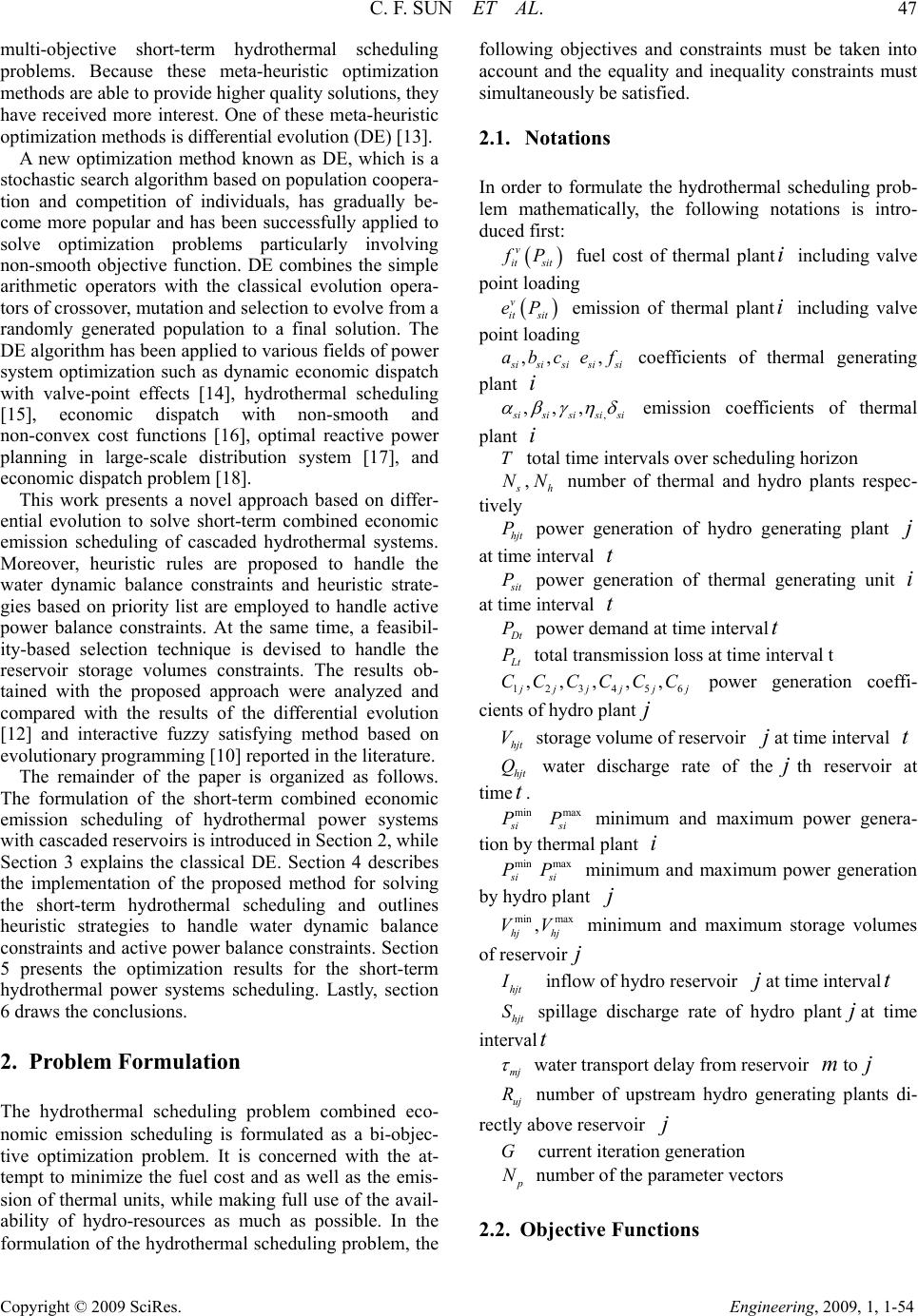 C. F. SUN ET AL. 47 Copyright © 2009 SciRes. Engineering, 2009, 1, 1-54 multi-objective short-term hydrothermal scheduling problems. Because these meta-heuristic optimization methods are able to provide higher quality solutions, they have received more interest. One of these meta-heuristic optimization method s is differential evolution (DE) [13]. A new optimization method known as DE, which is a stochastic search algorithm based on population coopera- tion and competition of individuals, has gradually be- come more popular and has been successfully applied to solve optimization problems particularly involving non-smooth objective function. DE combines the simple arithmetic operators with the classical evolution opera- tors of crossover, mutation and selection to evolve from a randomly generated population to a final solution. The DE algorithm has been applied to various fields of power system optimization such as dynamic economic dispatch with valve-point effects [14], hydrothermal scheduling [15], economic dispatch with non-smooth and non-convex cost functions [16], optimal reactive power planning in large-scale distribution system [17], and economic dispatch problem [18]. This work presents a novel approach based on differ- ential evolution to solve short-term combined economic emission scheduling of cascaded hydrothermal systems. Moreover, heuristic rules are proposed to handle the water dynamic balance constraints and heuristic strate- gies based on priority list are employed to handle active power balance constraints. At the same time, a feasibil- ity-based selection technique is devised to handle the reservoir storage volumes constraints. The results ob- tained with the proposed approach were analyzed and compared with the results of the differential evolution [12] and interactive fuzzy satisfying method based on evolutio nary progra mming [10] reported in the literature. The remainder of the paper is organized as follows. The formulation of the short-term combined economic emission scheduling of hydrothermal power systems with cascaded reservoirs is introduced in Section 2, while Section 3 explains the classical DE. Section 4 describes the implementation of the proposed method for solving the short-term hydrothermal scheduling and outlines heuristic strategies to handle water dynamic balance constraints and active power balance constraints. Section 5 presents the optimization results for the short-term hydrothermal power systems scheduling. Lastly, section 6 draws the conclusions. 2. Problem Formulation The hydrothermal scheduling problem combined eco- nomic emission scheduling is formulated as a bi-objec- tive optimization problem. It is concerned with the at- tempt to minimize the fuel cost and as well as the emis- sion of thermal units, while making full use of the avail- ability of hydro-resources as much as possible. In the formulation of the hydrothermal scheduling problem, the following objectives and constraints must be taken into account and the equality and inequality constraints must simultaneously be satisfied. 2.1. Notations In order to formulate the hydrothermal scheduling prob- lem mathematically, the following notations is intro- duced first: v it sit P fuel cost of thermal plant including valve point loading i v it sit eP emission of thermal plant i including valve point loading ,, isisi abc , isi ef coefficients of thermal generating plant i , ,,, isisisisi i T emission coefficients of thermal plant total time intervals over scheduling horizon N, number of thermal and hydro plants respec- tively h N hjt P power generation of hydro generating plant at time interval t it P power generation of thermal generating unt i at time interval i t t P power demand at time intervalt t P total transmission loss at time interval t 123456 ,,,,, jjjj CCCCCC j power generation coeffi- cients of hydro plant hjt V storage volume of reservoir at time interval t hjt Q water discharge rate of the th reservoir at time . t min i P minimum and maximum power genera- tion by thermal plant max si Pi min i Pmax si P minimum and maximum power generation by hydro plant min , hj VV max hj minimum and maximum storage volumes of reservoir hjt I at time interval inflow of hydro reservoir t hjt S spillage discharge rate of hydro plant at time interval t mj water transport delay from reservoir tom uj R number of upstream hydro generating plants di- rectly above reservoir G current iteration generation p N number of the parameter vectors 2.2. Objective Functions 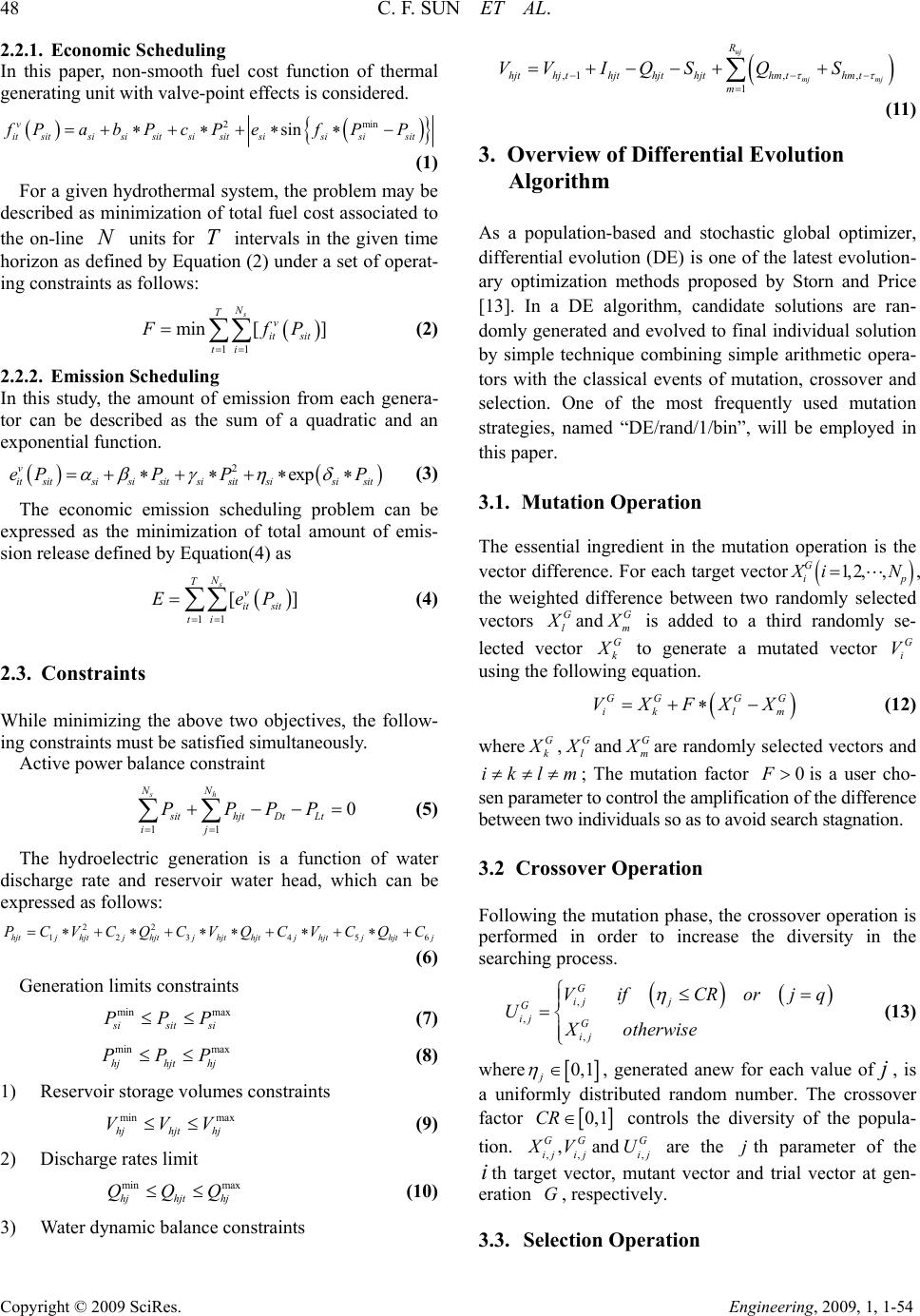 48 C. F. SUN ET AL. Copyright © 2009 SciRes. Engineering, 2009, 1, 1-54 l generating unit with valve-point effects is considered. 2.2.1. Economic Scheduling In this paper, non-smooth fuel cost function of therma 2min sin v itsitsisi sitsi sitsisisisit fPa bP cPefPP mf (1) For a given hydrothermal system, the problem may be described asinimization o total fuel cost associated to the on-line N units for intervals in the given time horizon as defined by Equation (2) under a set of operat- ing constraints as follo ws: P (2) the sum of a quadratic and an exponential functio n. amount of emis- sion release defined by Equation(4) as (4) .3. Constraint s follow- inultaneously. Active power balance constraint (5) ervoir water head, which can be expressed as follows: min [] s N Tv it sit i Ff 11 t 2.2.2. Emission Sche duling In this study, the amount of emission from each genera- tor can be described as exp tsitsisi sitsi sitsisi sit (3) The economic emission scheduling problem can be expressed as the minimization of total 2v i ePP PP 11 [] s N Tv it sit ti EeP 2 While minimizing the above two objectives, the g constraints must be satisfied sim 11ij The hydroelectric generation is a function of water discharge rate and res 0 sh NN sithjt Dt Lt PPPP 22 12 345hjtjhjtjhjtj hjthjtjhjtjhjt6j CV CQ CVQ CVCQC (6) Generation limits constraint (8) 1) Reserv oi r st or age volume (9) 2) Discharge rates limit (10) 3) Water dynamic balance constraints s min max sisit si PPP (7) min max hjhjt hj PPP s constraints min max hj VVV hj hjt min max hjhjt hj QQQ ,1, , 1 uj mj mj R hjthj thjthjthjthm thm t m VV IQSQS (11) 3. Overview of Differential Evolution Algorithm As a population-based and stochastic global optimizer, differential evolution (DE) is one of the latest evolution- ary optimization methods proposed by Storn and Price [13]. In a DE algorithm, candidate solutions are ran- domly generated and evolved to final individual solution by simple technique combining simple arithmetic opera- tors with the classical events of mutation, crossover and selection. One of the most frequently used mutation strategies, named “DE/rand/1/bin”, will be employed in this paper. 3.1. Mutation Operation The essential ingredient in the mutation operation is the vector difference. For each target vector, the weighted difference between two randomly selected vectors 1, 2,, G ip Xi N G l and G m is added to a third randomly se- lected vector G k to generate a mutated vector using the following equation. G i V GG GG ik lm VXFXX (12) whereG k ,G l and G m are randomly selected vectors and ik l m ; The mutation factor is a user cho- sen parameter to control t he amplification of the di fference between two individuals so as to avoid search stagnation. 0F 3.2 Crossover Operation Following the mutation phase, the crossover operation is performed in order to increase the diversity in the searching process. , , , G ij j G ij G ij Vif CRorjq UXotherwise (13) where 0, 1 j , generated anew for each value of , is a uniformly distributed random number. The crossover factor 0, 1CR , GG ij ij controls the diversity of the popula- tion. ,, V G and , are the th parameter of the th target vector, mutant vector and trial vector at gen- eration , respectively. G ij Uj i 3.3. Selection Operation 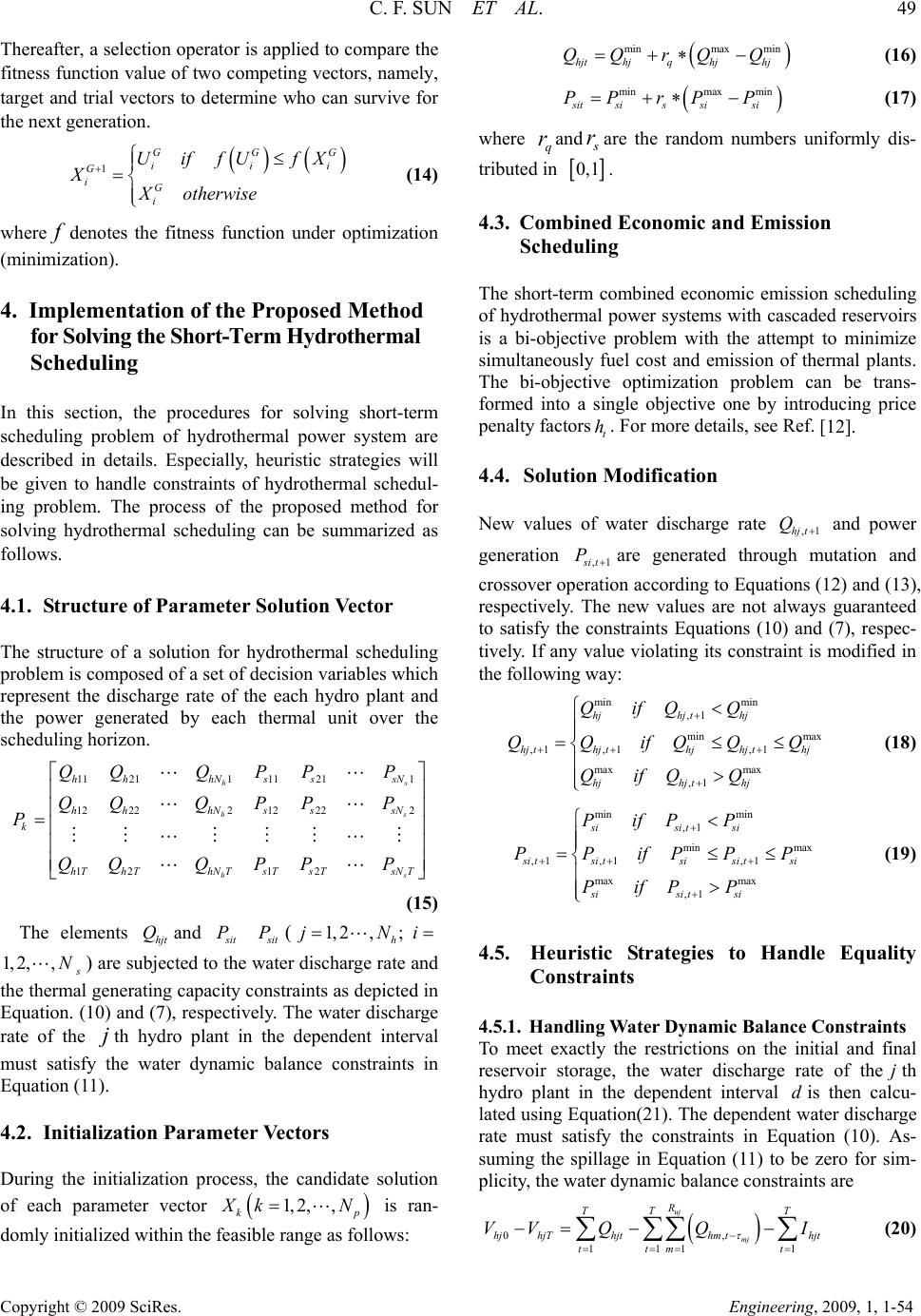 C. F. SUN ET AL. 49 Copyright © 2009 SciRes. Engineering, 2009, 1, 1-54 Thereafter, a selection operator is applied to compare the fitness function value of two competing vectors, namely, target and trial vectors to determine who can survive for the next generation. 1 GG ii G iG i UiffU fX XXotherwise G i (14) where denotes the fitness function under optimization (minimization). f 4. Implementation of the Proposed Method for Solving the Short-Term Hydrothermal Scheduling In this section, the procedures for solving short-term scheduling problem of hydrothermal power system are described in details. Especially, heuristic strategies will be given to handle constraints of hydrothermal schedul- ing problem. The process of the proposed method for solving hydrothermal scheduling can be summarized as follows. 4.1. Structure of Parameter Solution Vector The structure of a solution for hydrothermal scheduling problem is composed of a set of decision variables which represent the discharge rate of the each hydro plant and the power generated by each thermal unit over the scheduling horizon. 11211 11211 12222 12222 12 12 hs hs hs hhhNss sN hhhNss sN k hThThNTsTs TsNT QQQ PPP QQQPPP P QQQ PPP (15) The elements and hjt Q it P it P(1, 2,; h jNi 1, 2,, N) are subjected to the water discharge rate and the thermal generating capacity constraints as depicted in Equation. (10) and (7), respectively. The water discharge rate of the th hydro plant in the dependent interval must satisfy the water dynamic balance constraints in Equation (11). 4.2. Initialization Parameter Vectors During the initialization process, the candidate solution of each parameter vector 1, 2,, kp k minmax min hjt hjqhjhj QQ rQQ (16) minmax min sit sissisi PP rPP (17) where and are the random numbers uniformly dis- tributed in q rs r 0,1 . 4.3. Combined Economic and Emission Scheduling The short-term combined economic emission scheduling of hydrothermal power systems with cascaded reservoirs is a bi-objective problem with the attempt to minimize simultaneously fuel cost and emission of thermal plants. The bi-objective optimization problem can be trans- formed into a single objective one by introducing price penalty factors. For more details, see Ref. t h[12]. 4.4. Solution Modification New values of water discharge rate and power generation ,1hj t Q ,1 it P are generated through mutation and crossover operation according to Equations (12) and (13), respectively. The new values are not always guaranteed to satisfy the constraints Equations (10) and (7), respec- tively. If any value violating its constraint is modified in the following way: min min ,1 min max ,1 ,1,1 max max ,1 hjhj thj hj thj thjhj thj hjhj thj QifQ Q QQifQQQ QifQ Q (18) min min ,1 min max ,1 ,1,1 max max ,1 sisi tsi si tsitsisi tsi sisi tsi PifP P PPifPPP PifP P (19) 4.5. Heuristic Strategies to Handle Equality Constraints 4.5.1. Handling Water Dynami c Bal ance Constraints To meet exactly the restrictions on the initial and final reservoir storage, the water discharge rate of theth hydro plant in the dependent interval dis then calcu- lated using Equation(21). The dependent water discharge rate must satisfy the constraints in Equation (10). As- suming the spillage in Equation (11) to be zero for sim- plicity, the water dynamic balance constraints are j N is ran- domly initialized within the feasible range as follows: 0, 111 1 uj mj R TT T hjhjThjthm thjt ttmt VV QQI (20) 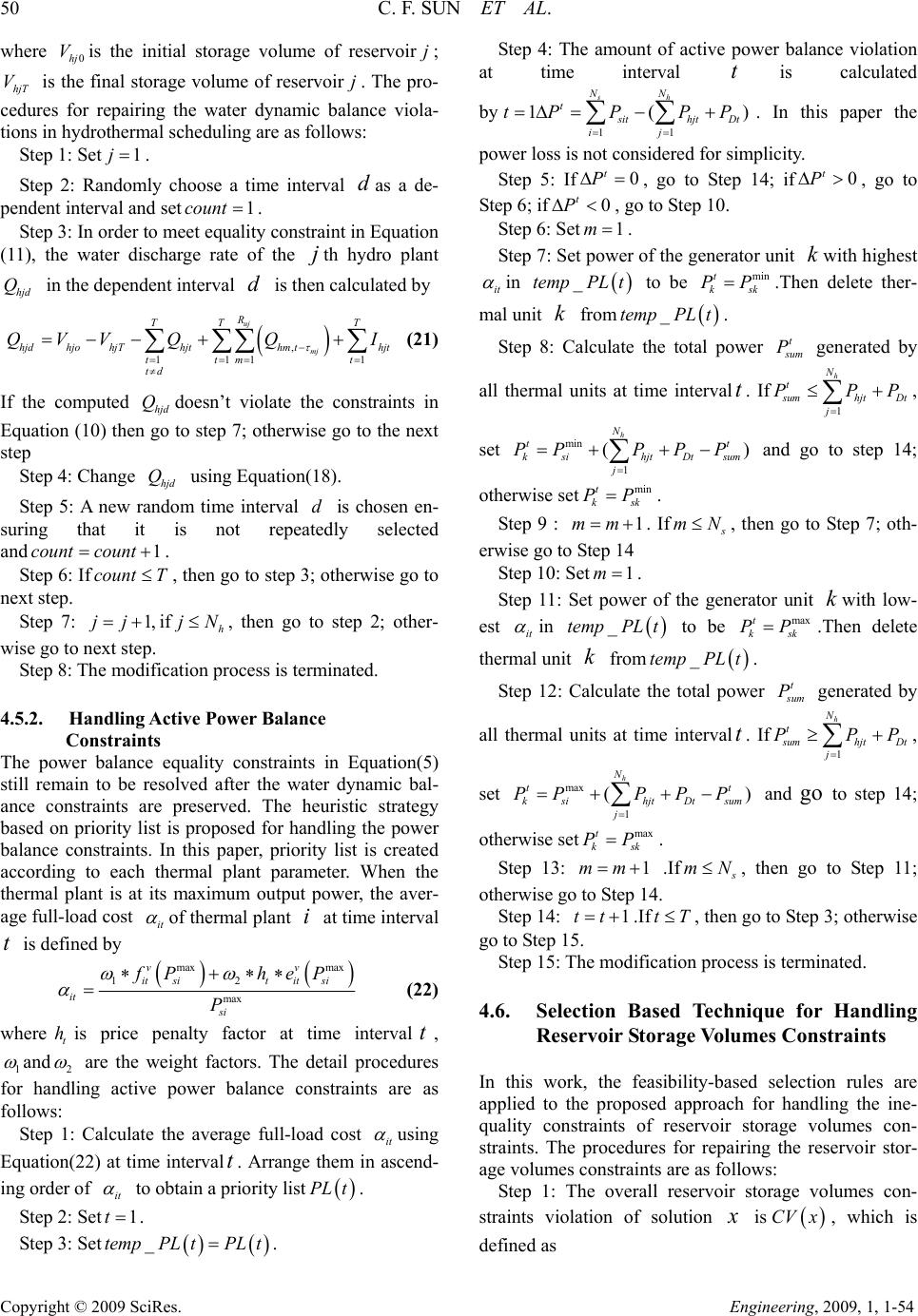 50 C. F. SUN ET AL. Copyright © 2009 SciRes. Engineering, 2009, 1, 1-54 where is the initial storage volume of reservoir; is the final storage volume of reservoir. The pro- cedures for repairing the water dynamic balance viola- tions in hydrothermal scheduling are as follows: 0hj V j hjT V j Step 1: Set. 1j Step 2: Randomly choose a time interval as a de- pendent interval and setd 1count . Step 3: In order to meet equality constraint in Equation (11), the water discharge rate of the th hydro plant in the dependent interval is then calculated by hjd Qd , 111 1 uj mj R TT T hjdhjohjThjthm thjt ttm t td QVVQQI (21) If the computed doesn’t violate the constraints in Equation (10) then go to step 7; otherwise go to the next step hjd Q Step 4: Cha n ge using Equation(18). hjd Q Step 5: A new random time interval is chosen en- suring that it is not repeatedly selected and . d 1count count Ste p 6 : I fcou , then go to step 3; otherwise go to next step. nt T Step 7: if , then go to step 2; other- wise go to next step. 1,jj h jN Step 8: The modification process is terminated. 4.5.2. Handling Active Power Balance Constraints The power balance equality constraints in Equation(5) still remain to be resolved after the water dynamic bal- ance constraints are preserved. The heuristic strategy based on priority list is proposed for handling the power balance constraints. In this paper, priority list is created according to each thermal plant parameter. When the thermal plant is at its maximum output power, the aver- age full-load cost it of thermal plant at time interval is defined by i t max max 12 max vv itsitit si it si fP heP P (22) where is price penalty factor at time interval, t ht 1 and 2 are the weight factors. The detail procedures for handling active power balance constraints are as follows: Step 1: Calculate the average full-load cost it using Equation(22) at time intervalt. Arrange them in ascend- ing order of it to obtain a priority list. PL t Step 2: Set. 1t Step 3: Set. _tempPLtPL t Step 4: The amount of active power balance violation at time interval tis calculated by 11 1( sh NN t) it hjt ij tP PP Dt P . In this paper the power loss is not considered for simplicity. Step 5: If0 t P 0 t , go to Step 14; if, go to Step 6; if 0 t P P , go to Step 10. Step 6: Set1m . Step 7: Set power of the generator unit with highest k it in _tempPL t ktemp to be .Then delete ther- mal unit from. mint ksk PP t_PL Step 8: Calculate the total power t um P t generated by all thermal units at time intervalt. If 1 h N um Phjt Dt j P ) t P, set and go to step 14; otherwise s et. min 1 ( h N t ksihjtDt m j PP PP mint ksk PP su P Step 9 : 1mm . If mN , then go to Step 7; oth- erwise go to Step 14 Ste p 10 : Se t1m . Step 11: Set power of the generator unit kwith low- it est in t to be.Then delete thermal unit from. _temp PL ktemp maxt ksk PP t t _PL Step 12: Calculate the total power um P t generated by all thermal units at time intervalt. If 1 h N um Phjt Dt j P ) P, set and go to step 14; otherwise se t. max 1 ( h N ksihjtDtm j PP PP maxt ksk PP tt su P Step 13: 1mm .If mN, then go to Step 11; otherwise go to Step 14. Step 14: 1tt .IftT , then go to Step 3; otherwise go to Step 15. Step 15: The mo dification process is terminated. 4.6. Selection Based Technique for Handling Reservoir Storage Volumes Constraints In this work, the feasibility-based selection rules are applied to the proposed approach for handling the ine- quality constraints of reservoir storage volumes con- straints. The procedures for repairing the reservoir stor- age volumes constraints are as follows: Step 1: The overall reservoir storage volumes con- straints violation of solution is, which is defined as CV x 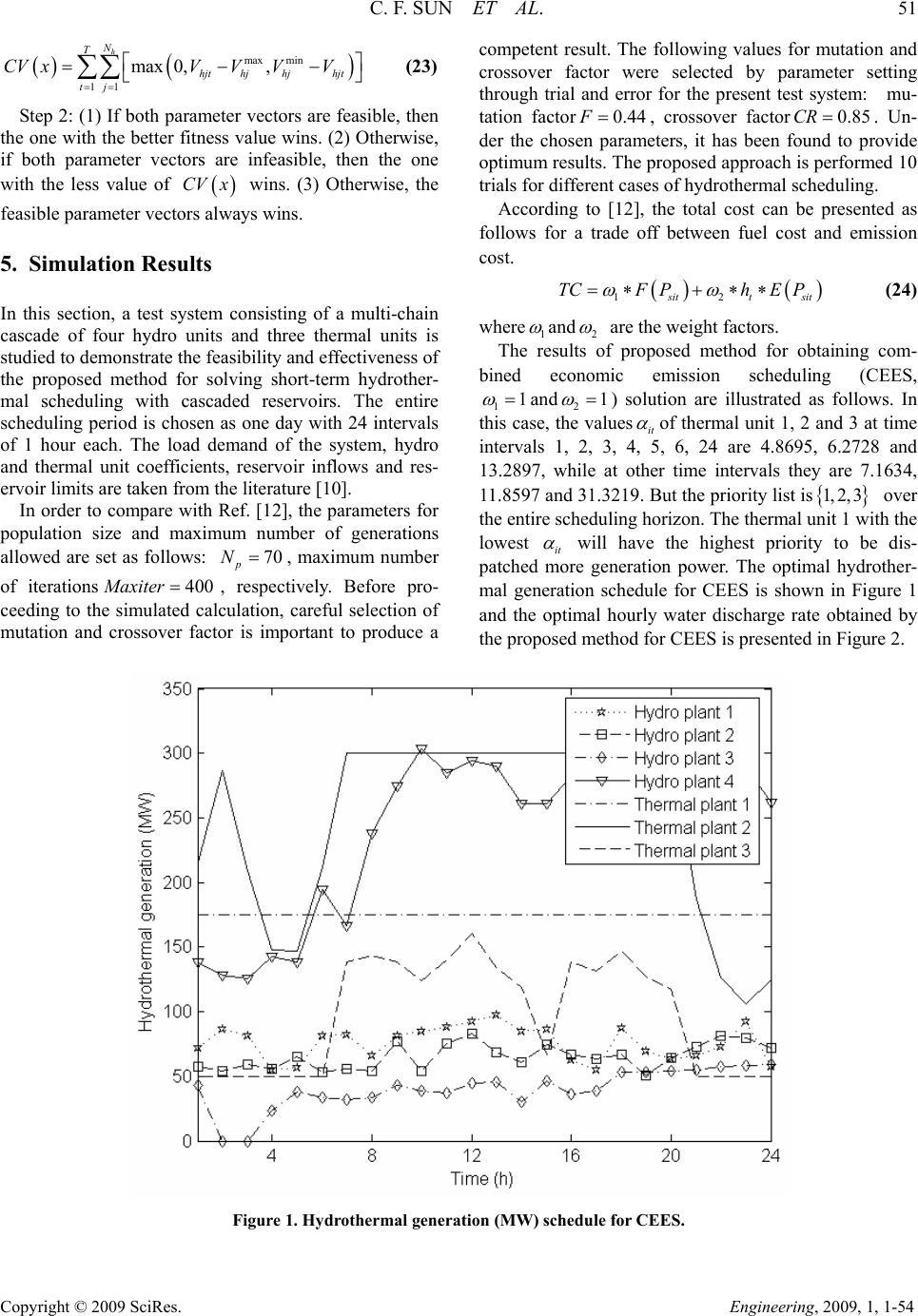 C. F. SUN ET AL. 51 Copyright © 2009 SciRes. Engineering, 2009, 1, 1-54 and errot system: max min 11 max 0,, h N T hjt hjhjhjt tj CV xVVVV (23) Step 2: (1) If both parameter vectors are feasible, then the one with the better fitness value wins. (2) Otherwise, if both parameter vectors are infeasible, then the one with the less value of wins. (3) Otherwise, the feasible parameter vectors always wins. CV x 5. Simulation Results In this section, a test system consisting of a multi-chain cascade of four hydro units and three thermal units is studied to demo ns trate th e feasibility an d effectiveness of the proposed method for solving short-term hydrother- mal scheduling with cascaded reservoirs. The entire scheduling period is chosen as one day with 24 intervals of 1 hour each. The load demand of the system, hydro and thermal unit coefficients, reservoir inflows and res- ervoir limits are taken from the literature [10]. In order to compare with Ref. [12], the parameters for population size and maximum number of generations allowed are set as follows: , maximum number of iterations, respectively. Before pro- ceeding to the simulated calculation, careful selection of mutation and crossover factor is important to produce a competent result. The following values for mutation and crossover factor were selected by parameter setting through trial r for the present tes mu- tation factor0.44F 70 p N 400Maxiter , crossover factor0.85CR . Un- der the chosen parameters, it has been found to provide optimum results. The proposed appr oach is performed 10 tri s forf between fuel cost ission cost. als for different cases of hydrot hermal schedu l i ng. According to [12], the total cost can be presented as follow a trade ofand em 12 it t TCF PhE sit P (24) where1 and 2 are the weight factors. The results of proposed method for obtaining com- ic emission scheduling (CEES, 11 bined econom and 21 ) sotion are illustrated as follows. In this case, the valuesit lu of thermal unit 1, 2 and 3 at time intervals 1, 2, 3, 4, 5, 6, 24 are 4.8695, 6.2728 and 13.2897, while at other time intervals they1634, 11.8597 and 31.3219 . But the pr iority list is 1, 2,3 over the entire scheduling horizon. The thermal unit 1 with the lowest it are 7. will have the highest priority to be dis- patched more generation power. The optimal hydrother- mal generation schedule for CEES is shown in Figure 1 and the optimal hourly water discharge rate obtained by the proposed method for CEES is presented in Figure 2. Figure 1. Hydrothermal generation (MW) schedule for CEES. 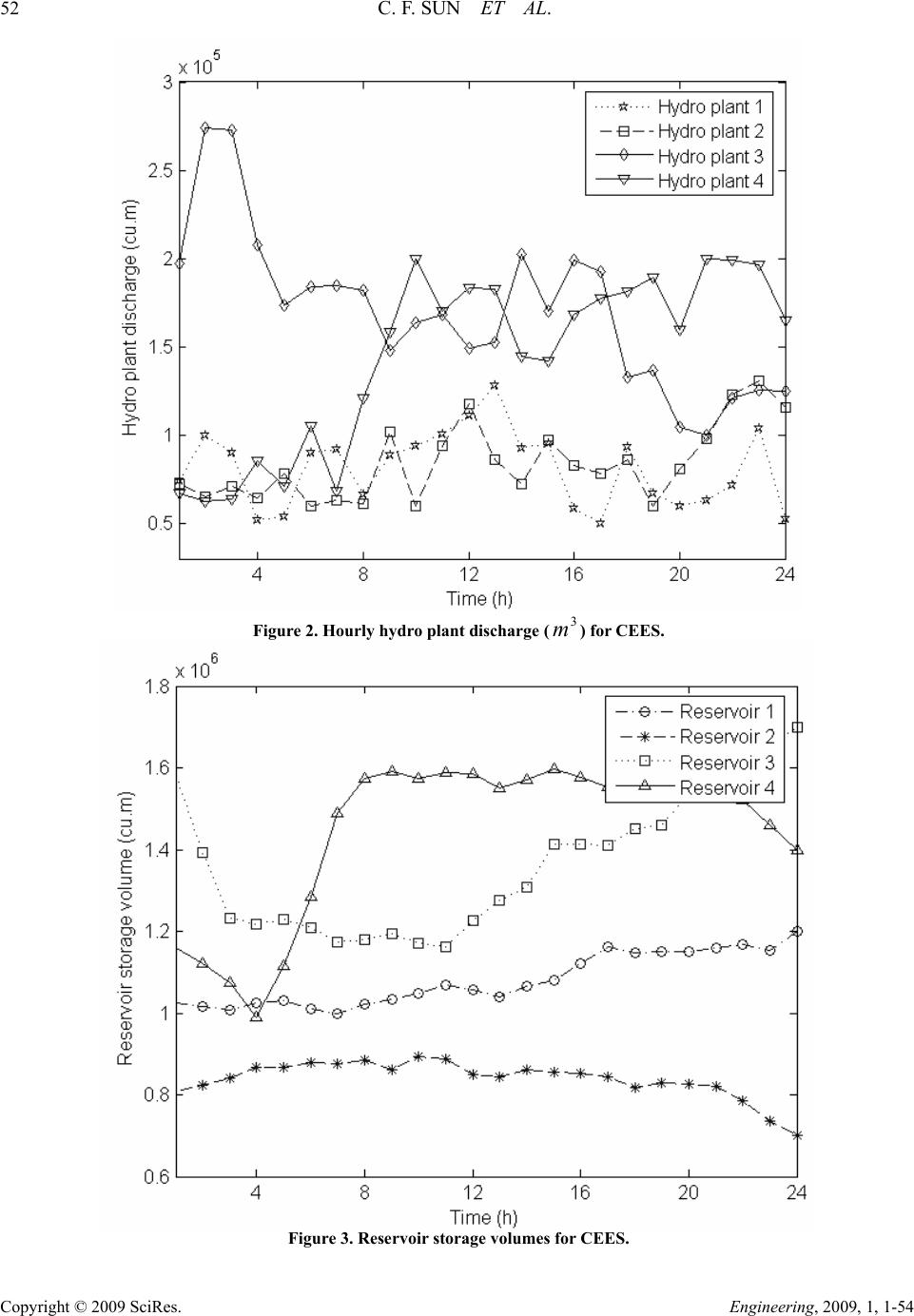 52 C. F. SUN ET AL. Copyright © 2009 SciRes. Engineering, 2009, 1, 1-54 Figure 2. Hourly hydro plant discharge () for CEES. 3 m Figure 3. Reservoir storage volumes for CEES. 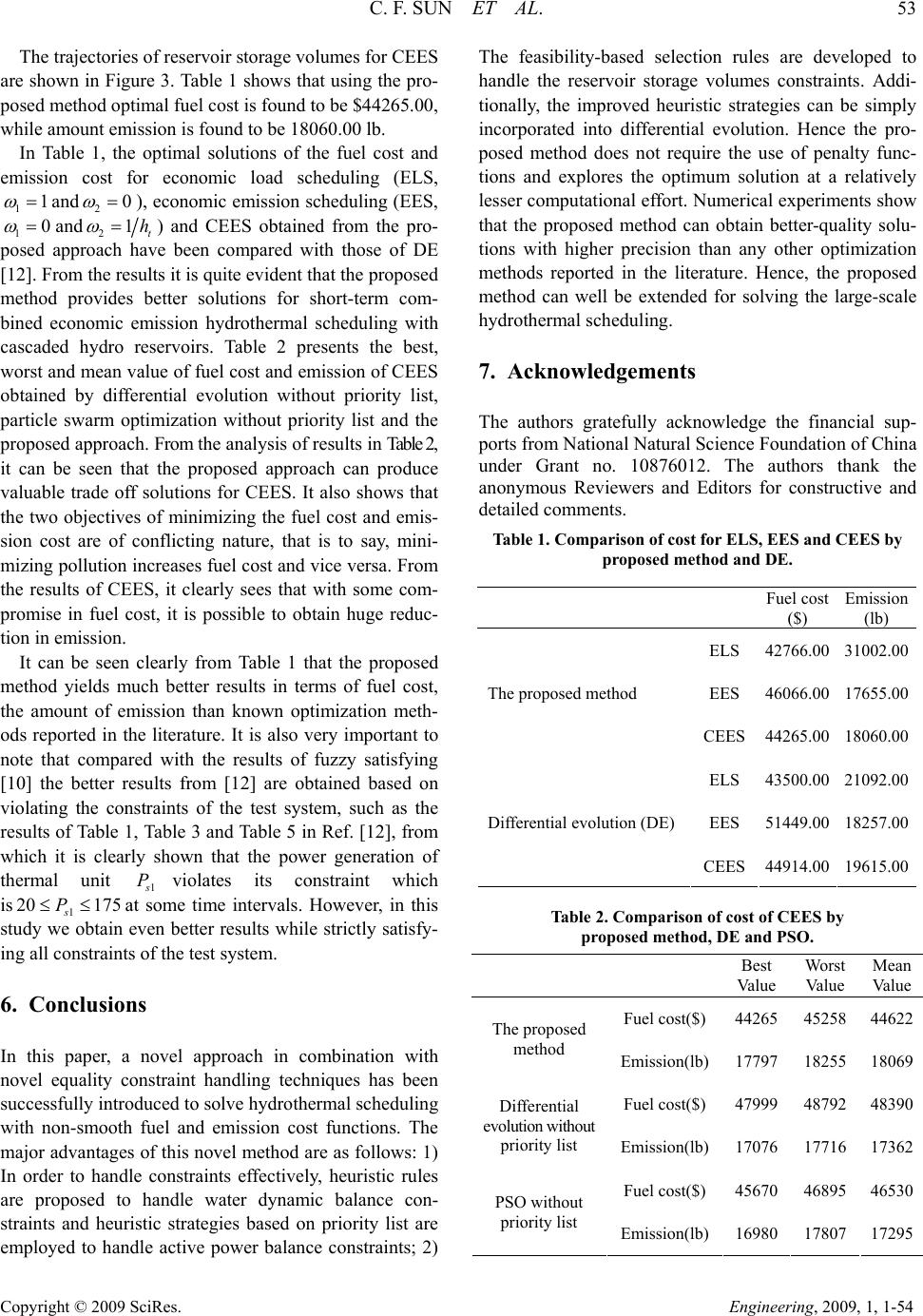 C. F. SUN ET AL. 53 Copyright © 2009 SciRes. Engineering, 2009, 1, 1-54 The trajectories of reservoir storage volumes for CEES are shown in Figure 3. Table 1 shows that using the pro- posed method optimal fuel cost is found to be $44265.00, while amount emission is found to be 18060.00 lb. In Table 1, the optimal solutions of the fuel cost and emission cost for economic load scheduling (ELS, 11 and 20 ), economic emission scheduling (EES, 10 and 21t h ) and CEES obtained from the pro- posed approach have been compared with those of DE [12]. From the results it is quite evident that the proposed method provides better solutions for short-term com- bined economic emission hydrothermal scheduling with cascaded hydro reservoirs. Table 2 presents the best, worst and mean value of fuel cost and emission of CEES obtained by differential evolution without priority list, particle swarm optimization without priority list and the proposed approach. From the analysis of results in Table 2, it can be seen that the proposed approach can produce valuable trade off solutions for CEES. It also shows that the two objectives of minimizing the fuel cost and emis- sion cost are of conflicting nature, that is to say, mini- mizing pollution increases fuel cost and vice versa. From the results of CEES, it clearly sees that with some com- promise in fuel cost, it is possible to obtain huge reduc- tion in emission. It can be seen clearly from Table 1 that the proposed method yields much better results in terms of fuel cost, the amount of emission than known optimization meth- ods reported in the literature. It is also very important to note that compared with the results of fuzzy satisfying [10] the better results from [12] are obtained based on violating the constraints of the test system, such as the results of Table 1, Table 3 and Table 5 in Ref. [12], from which it is clearly shown that the power generation of thermal unit 1 Pviolates its constraint which is 1at some time intervals. However, in this study we obtain even better results while strictly satisfy- ing all constraints of the test system. 20 175 s P 6. Conclusions In this paper, a novel approach in combination with novel equality constraint handling techniques has been successfully introduced to solve hydrothermal scheduling with non-smooth fuel and emission cost functions. The major advantages of this novel method are as follows: 1) In order to handle constraints effectively, heuristic rules are proposed to handle water dynamic balance con- straints and heuristic strategies based on priority list are employed to handle active power balance constraints; 2) The feasibility-based selection rules are developed to handle the reservoir storage volumes constraints. Addi- tionally, the improved heuristic strategies can be simply incorporated into differential evolution. Hence the pro- posed method does not require the use of penalty func- tions and explores the optimum solution at a relatively lesser computational effort. Numerical experiments show that the proposed method can obtain better-quality solu- tions with higher precision than any other optimization methods reported in the literature. Hence, the proposed method can well be extended for solving the large-scale hydrothermal scheduling. 7. Acknowledgements The authors gratefully acknowledge the financial sup- ports from National N a tur a l Science Foundation of China under Grant no. 10876012. The authors thank the anonymous Reviewers and Editors for constructive and detailed comments. Table 1. Comparison of cost for ELS, EES and CEES by proposed method and DE. Fuel cost $ Emission lb ELS 42766.0031002.00 EES 46066.0017655.00 The proposed method CEES 44265.0018060.00 ELS 43500.0021092.00 EES 51449.0018257.00 Differential evolution (DE) CEES 44914.0019615.00 Table 2. Comparison of cost of CEES by proposed method, DE and PSO. Best Value Worst ValueMean Value Fuel cost($) 44265 4525844622 The proposed method Emission(lb) 17797 1825518069 Fuel cost($) 47999 4879248390 Differential evolution without priority list Emission(lb) 17076 1771617362 Fuel cost($) 45670 4689546530 PSO without priority list Emission(lb) 16980 1780717295 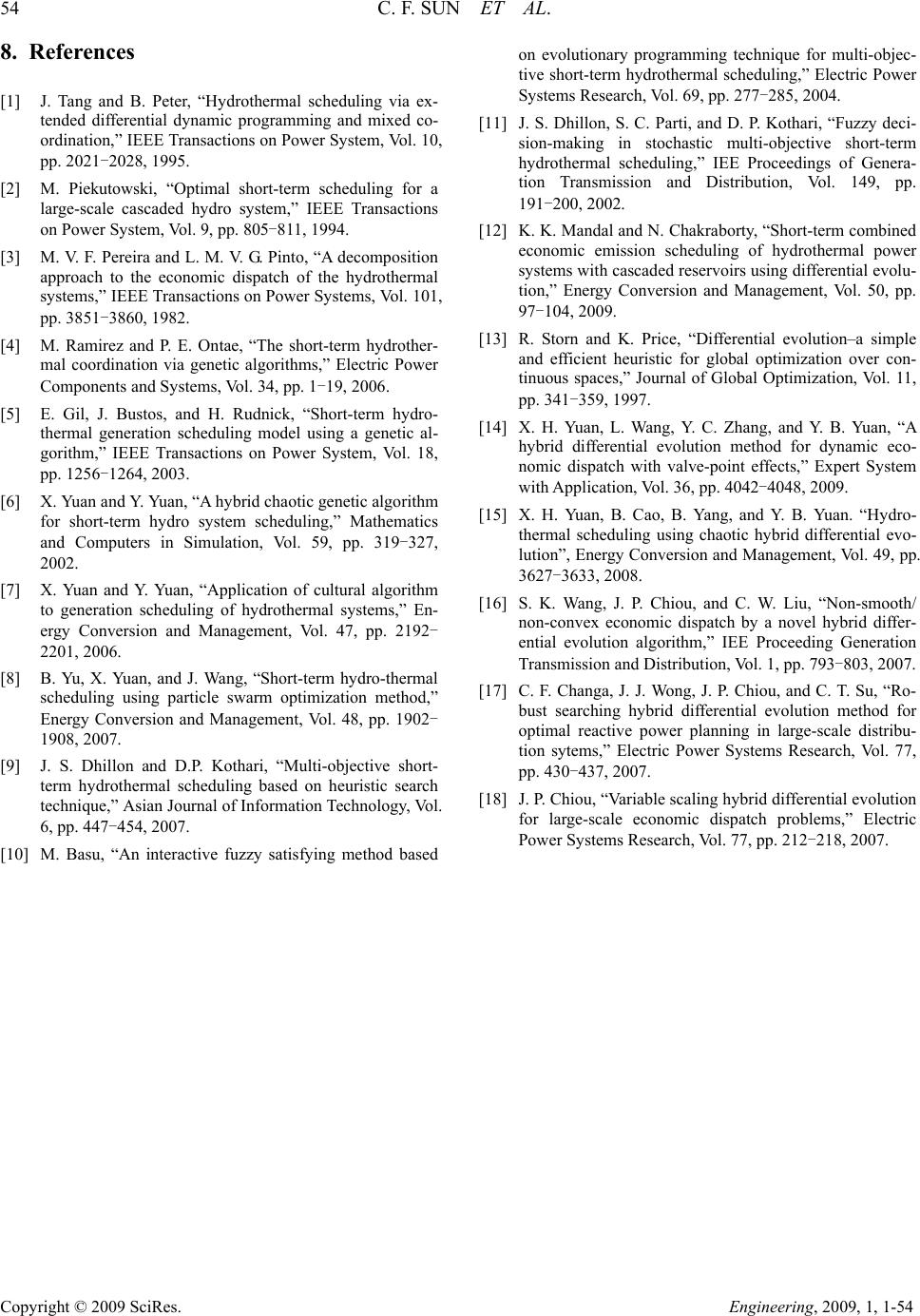 54 C. F. SUN ET AL. Copyright © 2009 SciRes. Engineering, 2009, 1, 1-54 8. References [1] J. Tang and B. Peter, “Hydrothermal scheduling via ex- tended differential dynamic programming and mixed co- ordination,” IEEE Transactions on Power System, Vol. 10, pp. 2021-2028 , 1 9 9 5 . [2] M. Piekutowski, “Optimal short-term scheduling for a large-scale cascaded hydro system,” IEEE Transactions on Power System, Vol. 9, pp. 805-811, 1994. [3] M. V. F. Pereira and L. M. V. G. Pinto, “A decomposition approach to the economic dispatch of the hydrothermal systems,” IEEE Transactions on Power Systems, Vol. 101, pp. 3851-3860 , 1 9 8 2 . [4] M. Ramirez and P. E. Ontae, “The short-term hydrother- mal coordination via genetic algorithms,” Electric Power Components and Systems, Vol. 34, pp. 1-19, 2006. [5] E. Gil, J. Bustos, and H. Rudnick, “Short-term hydro- thermal generation scheduling model using a genetic al- gorithm,” IEEE Transactions on Power System, Vol. 18, pp. 1256-1264 , 2 0 0 3 . [6] X. Yuan and Y. Yuan, “A hybrid chaotic genetic algorithm for short-term hydro system scheduling,” Mathematics and Computers in Simulation, Vol. 59, pp. 319-327, 2002. [7] X. Yuan and Y. Yuan, “Application of cultural algorithm to generation scheduling of hydrothermal systems,” En- ergy Conversion and Management, Vol. 47, pp. 2192- 2201, 2006. [8] B. Yu, X. Yuan, and J. Wang, “Short-term hydro-thermal scheduling using particle swarm optimization method,” Energy Conversion and Management, Vol. 48, pp. 1902- 1908, 2007. [9] J. S. Dhillon and D.P. Kothari, “Multi-objective short- term hydrothermal scheduling based on heuristic search technique,” Asian Journal of Information Technology, Vol. 6, pp. 447-454, 2007. [10] M. Basu, “An interactive fuzzy satisfying method based on evolutionary programming technique for multi-objec- tive short-term hydrothermal scheduling,” Electric Power Systems Research, Vol. 69, pp. 277-285, 2004. [11] J. S. Dhillon, S. C. Parti, and D. P. Kothari, “Fuzzy deci- sion-making in stochastic multi-objective short-term hydrothermal scheduling,” IEE Proceedings of Genera- tion Transmission and Distribution, Vol. 149, pp. 191-200, 2002. [12] K. K. Mandal and N. Chakraborty, “Short-term combined economic emission scheduling of hydrothermal power systems with cascaded reservoirs using differential evolu- tion,” Energy Conversion and Management, Vol. 50, pp. 97-104, 2009. [13] R. Storn and K. Price, “Differential evolution–a simple and efficient heuristic for global optimization over con- tinuous spaces,” Journal of Global Optimization, Vol. 11, pp. 341-359, 1997. [14] X. H. Yuan, L. Wang, Y. C. Zhang, and Y. B. Yuan, “A hybrid differential evolution method for dynamic eco- nomic dispatch with valve-point effects,” Expert System with Application, Vol. 36, pp. 4042-4048, 2009. [15] X. H. Yuan, B. Cao, B. Yang, and Y. B. Yuan. “Hydro- thermal scheduling using chaotic hybrid differential evo- lution”, Energy Conversion and Management, Vol. 49, pp. 3627-3633, 2008. [16] S. K. Wang, J. P. Chiou, and C. W. Liu, “Non-smooth/ non-convex economic dispatch by a novel hybrid differ- ential evolution algorithm,” IEE Proceeding Generation Transmission and Distribution, Vol. 1, pp. 793-803, 2007. [17] C. F. Changa, J. J. Wong, J. P. Chiou, and C. T. Su, “Ro- bust searching hybrid differential evolution method for optimal reactive power planning in large-scale distribu- tion sytems,” Electric Power Systems Research, Vol. 77, pp. 430-437, 2007. [18] J. P. Chiou, “Variable scaling hybrid differential evolution for large-scale economic dispatch problems,” Electric Power Systems Research, Vol. 77, pp. 212-2 1 8, 2007.
|